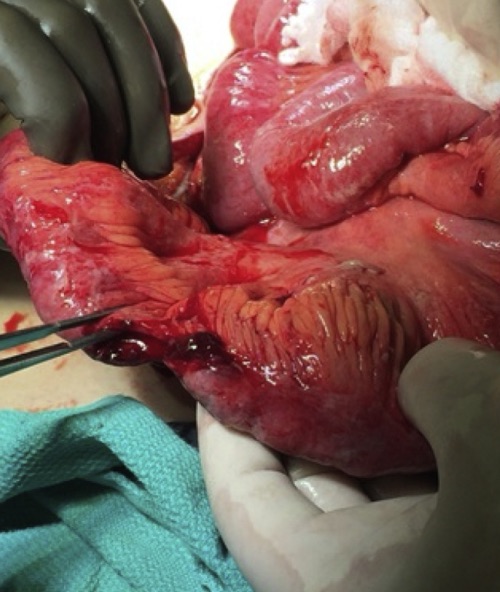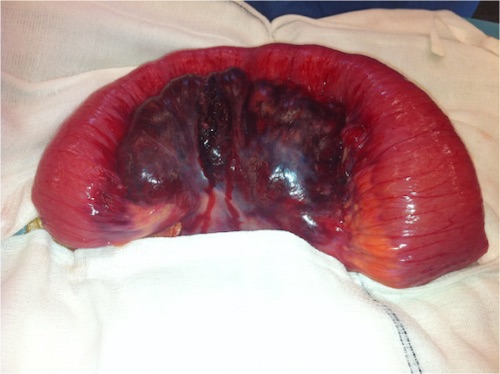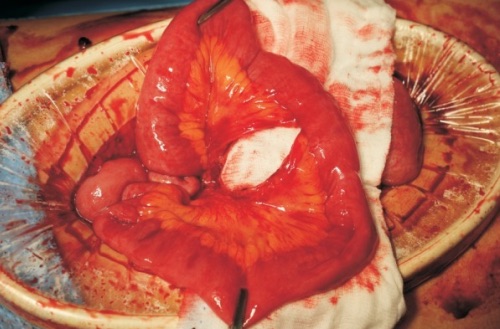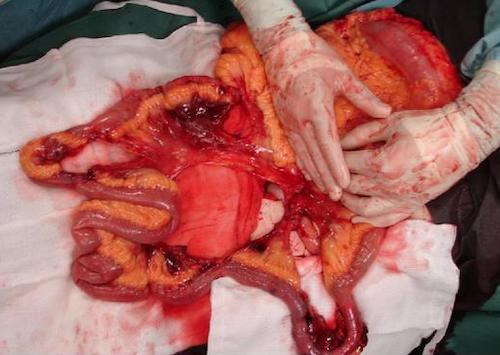Small Bowel (Jejunum/Ileum) Trauma
Small Bowel (Jejunum/Ileum) Trauma
David Ray Velez, MD
Table of Contents
Background
Presentation and Diagnosis
Treatment
Mesenteric Injury
Duodenal Trauma is Generally Considered Separate from Other Small Bowel Trauma – *See Duodenal Trauma
Background
Etiology
- The Most Commonly Injured Organ (50%) After Penetrating Abdominal Trauma
- Third Most Common Injury (5-10%) After Blunt Abdominal Trauma
- Behind Spleen and Liver
- Blunt Injuries are Most Often Near Sites of Attachment (Ligament of Treitz, Ileocecal Valve, or Adhesions)
Mechanism of Injury
- Penetrating Mechanisms:
- Direct Injury – Tearing & Crushing Force Through Tissue Along the Trajectory of the Projectile & its Fragments
- Gunshot Wounds Have an Additional Dissipation of Kinetic Energy That Causes Further Damage
- Cavitation – As a High Energy Projectile Moves Through Tissue Energy Causes a Radial Stretching, Forming a Temporary Cavity with Additional Tissue Damage
- Higher Energy Projectiles Create Larger Cavities & Cause More Damage
- Shock Wave – The Projectile Creates Rapid Changes in Pressure & Temperature that Propagate Through Tissue Causing Additional Injury
- Direct Injury – Tearing & Crushing Force Through Tissue Along the Trajectory of the Projectile & its Fragments
- Blunt Mechanisms:
- Crushing Force – Direct Compression Causing Injury
- Shearing Force – Tearing from Acceleration/Deceleration Around Fixed Attachments
- Bursting Force – Force Causing Acutely Increased Intraluminal Pressure within Hollow Organs Leading to Rupture

Small Bowel Perforation 1
Presentation and Diagnosis
Presentation
- Mostly Nonspecific
- Abdominal Pain
- Nausea and Vomiting
May Be Diagnosed on CT or Intraoperatively
Small Bowel is the Most Commonly Missed Abdominopelvic Injury on CT in Trauma
AAST Small Bowel Injury Grade
- *See AAST
- Injury Scale is Under Copyright
Treatment
Delay to Surgery with Perforation is Associated with Increased Morbidity and Mortality
Free Fluid on CT without Solid Organ Injury Should Raise Immediate Concern for Hollow Viscus Injury – Does Not Absolutely Mandate Surgical Exploration but Should At Least Be Monitored Closely with Serial Examinations if Not Operating
Intramural Hematoma: Generally Managed Conservatively (Explore if Large or Expanding)
Definition of “Destructive” Bowel Injury
- Laceration > 50% Circumference or Transection
- Devascularized or “Bucket Handle” Injury
Non-Destructive Injury (Grade I-II): Primary Repair
- Close Transversely to Avoid Stricture if Able
- Close in One or Two-Layers – No Difference in Complication Rates
- May Convert Two Perforations Closely Opposed into a Single Defect
- Consider Resection if There are Multiple Small Perforations in a Short Segment
Destructive Injury (Grade III-V): Small Bowel Resection
- Anastomosis Can Be Handsewn or Stapled – No Difference in Complication Rates
- Close the Mesenteric Defect to Prevent Internal Hernia
Leave as Much Bowel as Possible with the Fewest Number of Repairs or Anastomoses to Prevent Short Gut Syndrome – *See Intestinal Failure – The O.R.
Mesenteric Injury
Mesenteric Hematoma
- Small and Nonexpanding: Conservative Management
- Large or Expanding: Explore and Evacuate the Hematoma
Mesenteric Tear
- Close All Defects to Prevent Internal Hernia
- Tear Alone Does Not Mandate Bowel Resection Unless Devascularized
“Bucket Handle” Injury
- Definition: Mesenteric Separation from the Bowel Causing Devascularization
- Most Common After Motor Vehicle Crash (MVC) – Requires Significant Force
- Most Common Site: Terminal Ileum
- Tend to Occur Near Areas of Fixation (Cecum/Ligament of Treitz)
- Treatment: Resection of Devitalized Bowel

Mesenteric Hematoma 2

Mesenteric Tear 3

Multiple Bucket Handle Injuries 4
References
- Lucke-Wold BP, Cook P, Shorter N, Bonasso P. Abdominal trauma leading to diagnosis of Crohn’s disease. Int J Surg Case Rep. 2016;26:154-5. (License: CC BY-NC-ND-4.0)
- Ashrafian H, Manfield JH, Mitra A, Boyle DJ, Mathur P. Spontaneous mesenteric hematoma complicating an exacerbation of Crohn’s disease: report of a case. BMC Surg. 2014 Jun 3;14:35. (License: CC BY-2.0)
- Go SJ, Sul YH, Ye JB, Kim JS. Appendiceal transection associated with seat belt restraint. Ann Surg Treat Res. 2016 Aug;91(2):93-5. (License: CC BY-NC-4.0)
- O’Dowd V, Kiernan C, Lowery A, Khan W, Barry K. Seatbelt injury causing small bowel devascularisation: case series and review of the literature. Emerg Med Int. 2011;2011:675341. (License: CC BY-3.0)
